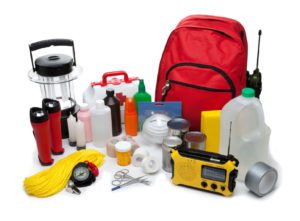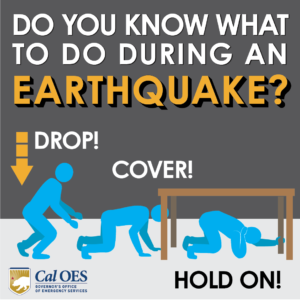Millions of California homes are vulnerable to earthquake damage, and most are within 30 miles of an active fault. And many of those older homes may not be seismically strengthened. If your home is among those more vulnerable to shake damage, check out these earthquake safety tips so that you can:
- Protect your home from structural damage due to earthquakes.
- Protect your most valuable asset, your home, and your savings from financial ruin.
- Protect the safety of you and your family living inside the home.
HOW CAN I PREPARE FOR AN EARTHQUAKE AT HOME?
Being prepared for an earthquake is important to help you survive and recover. By knowing your home’s weak spots, and what earthquake risks and hazards are near your home, you can be better prepared before the next one strikes. Understanding the types of possible injuries that could occur, and taking steps to reduce risk and to create plans and kits are some of the first steps in making your home safer for you and your family.
What causes the most injuries in the home due to an earthquake?
Most earthquake injuries in the home occur due to fallen heavy furniture, shaken appliances and shattered window glass.
Eliminate earthquake hazards in your home. Stay safe and prepare your home. Identify and secure appliances, artwork, large mirrors and heavy furniture. Reduce your chances of injury by following these earthquake safety precautions.
Identify earthquake hazards inside your home
If you live in an older home that was built before 1980, it may be more vulnerable to earthquake shaking because these homes were built before modern seismic building codes were in place. You can hire a professional to do a home inspection, to let you know if your home is securely anchored to its foundation, and they can also look at other parts of your home to check for vulnerabilities, including chimneys, fireplaces, porches, decks, carports and garages.
Top 7 Ways to Reduce Earthquake Hazards in the Home Checklist
You and your family can take steps now to reduce home hazards. Follow these earthquake safety steps for earthquake preparedness:
- Remove heavy, unstable items from doorways
- Follow California law and brace water heaters with straps to studs.
- Make sure you have flexible connections where gas lines hook up to appliances.
- Secure overhead lighting.
- Bolt bookshelves to wall studs.
- Move beds away from windows.
- Don’t hang heavy items above couches, chairs or beds.
Take the time for safe family planning
Earthquake safety home drills and family communications plans go a long way to achieving earthquake safety preparedness. Work on building a family safety plan.
- Practice Drop, Cover, and Hold On.
- Gather contact information about your family and other important organizations such as doctors’ offices, schools and hospitals. Enter this information into everyone’s mobile phones.
- Identify an out-of-city contact person’s name and number and a reunion location.
- Find an easily reachable location to store your emergency supplies.
- In case power is off and your phone battery dies, also store important information on paper. Keep copies in backpacks, briefcases, handbags and autos.
- Register for the MyShake app.
- Review and practice your emergency plan during regular family meetings.
Get earthquake supplies organized

Keep your earthquake emergency kits ready and within reach. Follow the full list of suggested earthquake safety preparation supplies on Ready.gov.
The rule of thumb is three days’ supply of water and food for each member of your household. Don’t forget your pet’s food and water. Include extra flashlights and batteries, portable radios, a first aid kit, medications and a whistle.
Store supplies in your home, your car, and your workplace.
Protect your financial information
Consider storing financial documents in the cloud securely or on a portable drive inside your earthquake emergency kit. Think about including some or all of the following documents as part of your earthquake safety procedures:
- Mortgage documents or title to your home and your home insurance.
- Vehicle Identification Number, registration, title, auto insurance and loan/pink slip.
- Checking, savings, debit cards, retirement account statements and life insurance policies.
- Income tax returns, property tax information, and vehicle tax information.
- Wills, trusts and power of attorney documents.
For more information on collecting and safeguarding important information, download FEMA’s Emergency Financial First Aid Kit.
BE SAFE WHEN THE SHAKING STOPS
When a major earthquake strikes: remember to Drop, Cover, and Hold On. Earthquake safety preparation begins with knowing what to do when the ground shakes without warning. To get up to 10-20 seconds’ notice of a coming earthquake, sign up for the MyShake app today.
Practice the earthquake safety steps: Drop, Cover, and Hold On
It is critical that your family regularly practices the following earthquake safety steps:

- Drop. Drop to the floor onto your hands and knees.
- Cover. Find cover. Shelter under a heavy table or desk. Cover your head and neck with your arms. If shelter is unavailable, cover your face and head with your arms and crouch in an inside corner or near an interior wall (away from windows) of the building. If in bed, stay there and use a pillow to protect your head and neck.
- Hold On. Stay put until shaking stops.
- If it is safe to do so, grab your earthquake supply kit.
Retrofits to strengthen your home
Knowing your home’s structural strengths and weaknesses is important to your earthquake safety preparation. If you own an older home, you should consider a seismic retrofit.
A California licensed contractor with seismic retrofitting experience can assist you with an inspection and any retrofit work or repairs. Explore possible grants and learn how to pay for your retrofit. Funding may be available to you through the California Earthquake Brace + Bolt program.
STEPS TO FOLLOW AFTER AN EARTHQUAKE TO RECOVER QUICKER
When the shaking stops, check yourself and others for injuries. Carefully check your home and surroundings for damage. Because aftershocks are common, continue to follow your earthquake safety precautions.
- Dial 9-1-1 if anyone is seriously injured.
- Turn on the radio for important information and instructions.
- Inspect water, gas, and electric lines for damage.
- Leave the house immediately if you smell gas. Report the leak to the authorities.
- Check for cracks and damage to the roof and foundation of your home.
- Watch for tripping hazards due to broken glass and debris.
- Keep out of damaged buildings and areas.
Build disaster resilience
After an earthquake, seismic aftershocks can continue to occur for days and even weeks. Sometimes aftershocks cause additional damage to weaken houses. Follow these earthquake safety tips:
- When the ground shakes, Drop, Cover, and Hold On.
- Monitor local radio reports and government websites.
- Message your out-of-area contact to update your status.
- Stay off the phone. Keep lines open for emergency responders. Text if necessary.
- If your home has been damaged because of quake damage or you cannot live in your damaged home, there may be resources to help. If an emergency is declared, FEMA may offer limited financial assistance. State and local government sources may also offer aid.
- If your home needs repairs, use a state licensed contractor, who has experience with seismic retrofits. Try to obtain at least three bids.
BENEFITS OF A SEISMIC RETROFIT
The benefits of a seismic retrofit of your home include increased safety, protecting the investment of your home, and decreasing the likelihood that you’ll have to move out after an earthquake due to damage from shaking.
Get to know your home’s earthquake resistance. An important earthquake safety precaution is discovering your home hazards. With an onsite visit with a licensed contractor or seismic engineer, you will learn which structural elements of your home need reinforcing. Common retrofits include the following types of work:
- Install anchor bolts or steel plates to connect your home to its raised foundation.
- Strengthen your home’s crawl space wall, the short wood-stud wall between the top of the foundation wall and the first floor.
- Support unreinforced chimneys, masonry and concrete walls, and foundations.
- Reinforce large openings like garage doors if there is living space above them.
How to retrofit
It’s important to understand that different types of home styles face different risks and hazards—and require different earthquake safety precautions. For example, some homes with a raised foundation may require a new continuous concrete footing, and other types may need plywood bracing and bolting. In a major earthquake, there are different potential structural risks depending on your type of home.
- Stem wall houses may require foundation anchor bolting.
- A crawl space house may require plywood bracing and bolting.
- If there is a living space over a garage, the structure may need to be retrofitted by installing plywood sheathing and steel columns.
- Bracing or removing/replacing unreinforced chimneys, masonry and concrete walls.
Learn more about how to strengthen your specific home type with a seismic retrofit.
Is a retrofit worth it?
Earthquakes can cause homes and mobile homes to move off their foundations, windows to shatter, and gas lines to rupture. Your home also may be vulnerable to serious structural damage if it was built before 1980. The violent shaking from earthquakes can rupture the earth, trigger landslides and turn the surface of the earth to liquid. Identify the geologic hazards near you.
Your home’s location near a fault, level of earthquake risk, and foundation type are key factors in earthquake safety preparedness. Retrofits safeguard your family’s safety and your investment in your property.
See how to get financial help to pay for a retrofit.
Reinforce your house
Earthquake safety preparation begins with getting to know your home’s earthquake resistance. Check with a licensed contractor or seismic engineer to learn whether the structural elements of your home need reinforcing.
Assistance with retrofitting to help you pay for your retrofit may be available through your county or the California Earthquake Brace + Bolt program.
STRENGTHEN YOUR HOME!
A small investment in retrofitting and earthquake safety preparation will provide big benefits when the next major California earthquake hits.
Be ready for the next big California earthquake by strengthening your house. Find out about brace and bolt grants to help you prepare and pay for your retrofit.
To learn more on how to prepare for an Earthquake visits Cal OES’s Website

